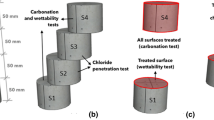Abstract
Coatings can contribute to extending service life of concrete structures exposed to marine environents by reducing the rate of chloride penetration. In the present paper, the effect of coatings on the rate of chloride uptake was studied by measuring their concentration profiles at different, times, extending up to 24 months. Using a solution of the so-called Fick’s second law of diffusion, least-square fitting leads to the value of chloride concentration under the coating (C o ) which allowed us to compare the effectiveness of different coatings. Dependeng on the formulation, some of the studied acrylic coatings could reduce the value ofC o by more than 80% in comparison to the unpainted concrete. Water permeability coefficients were measured for the same coatings, according to EN 1062-3. The ranking of effectiveness to stop chlorides is the same as the water imperviousness, but the minimum requrement proposed by prEN 1504-2 (0.1 kg.m−2h−0.5) did not prove to be enough for an efficient protection against chloride permeation.
Résumé
Les revêtements peuvent contribuer à l’extension de la durée de vie des structures en béton exposées à des environments marins en réduisant le taux de pénétration des chlorures. Dans cet article, l’effet des revêtements sur le taux de pénétration des chlorures dans le béton a été suivi en mesurant leurs profils de concentration à des périodes différentes jusqu’à 24 mois d’exposition. En utilisant une solution de la seconde Loi de Fick, nous avons appliqué la méthode des moindres carrés au taux de concentration en ions chlorures sous le revêtement (Co), afin de comparer l’efficacité de plusieurs revêtements. Selon la formulation, quelques peintures acryliques qui ont été étudiées ont pu réduire la valeur de Co de plus de 80% en comparaison avec le béton sans revêtement. Les coefficients de perméabilité à l’eau des mêmes revêtements ont été obtenus d’après la norme européene EN 1062-3. Le classement des revêtements par degré d’efficacité contre l’entrée des chlorues est le même que pour leur imperméabilité à l’eau, mais la quantié minimale mentionnée dans le projet de norme européenne EN 1504-2 (0,1 kg.m−2.h−0,5) n’est pas suffisante pour que le revêtement protège de façon efficace le béton contre la pénétration des chlorures.
Similar content being viewed by others
References
Kreijger, P. C., 1984. ‘The skin of concrete. Composition and properties’,Mater. Struct.,17, 100275–283.
‘Détermination rapide de la carbonatation du béton’,Bulletin du Ciment 8 (Août 1988).
Duval, R., ‘La durabilité des armatures et du béton d’enrobage’ in “La durabilité des bétons”, Cap. 6. Presses de l’École Nationale des Ponts et chaussées, Paris (1992).
pr EN 1504-2, Products and systems for the protection and repair of concrete structures. Definitions—Requirements—Quality control and evaluation of conformity. Part 2: Surface protection systems, (2000).
Basheer, P. A. M., ‘Surface treatments for concrete’, Keynote lecture, Session on Preventive measures COST 509 Workshop, 4–9 September 1995, Seville, Spain.
ENV 1504-9, Products and systems for the protection and repair of concrete structures. Definitions—Requirements—Quality control and evaluation of conform ty. Part 9: General principles for the use of products and systems (1997).
Rodrigues, M. P. M. C., ‘Durability of organic coatings for protection of reinforced concrete’, Thesis presented to Faculdade de Engenharia da Universidade do Porto. LNEC, Lisboa, February 1998 (in Portuguese).
Cussler, E. L., in ‘Diffusion: Mass transfer in fluid systems’, Cambridge Univ. Press (1998).
Higa, M. and Kira, A. ‘A new equation of ion flux in a membrane: inclusion of frictional force generated by electric field’J. Phys. Chem.,98 (25) (1994) 6339–6342.
Krisna, R. and Wesselingh, J. A., ‘The Maxwell-Stefan approach to mass transfer’Chem. Eng. Sci,52 (6) (1997) 861–911.
Lowrey, E. and Broome, T., ‘Practical application of modern permeability theory in the paint industry’,J. Paint Tech.,38 (495) (1966) 227–249.
Perera, D. Y. and Selier, P., ‘Water transport in organic coatings’,Prog. Org. Coat.,1 (1973) 57–80.
Blahník, R., ‘Problems of measuring water sorption in organic coatings and films, and calculation of complicated instances of moistening’,Progress in Organic Coatings,11 (4) (1983) 353–392.
Crank, J. in ‘The mathematics of diffusion’, Oxford University Press, 2nd. Ed., USA (1975).
Kropp, J., ‘Chlorides in concrete’ in ‘Performance Criteria for Concrete Durability’, RILEM Report 12 (E&FN Spon), (1995) 138–164.
Bird, R. B., Stewart, W. E. and Lightfoot, E. N., ‘Transport Phenomena’, Wiley, New York (1960).
Bamforth, P. B. and Chapman-Andrews, J., ‘Long term performance of RC elements under UK coastal conditions’ in Proc. of International Conf. ‘Corrosion and Corrosion Protection of Steel in Concrete’, (ed R. Narayan Swamy), UK University of Sheffield, 24–29 July 1994.
Mustafa, M. A. and Yusof, K. M., ‘Atmospheric penetration into concrete in semi-tropical marine environment’,Cement and Concrete Research 24(4) (1994) 661–670.
Salta, M. M., ‘Influence of fly ash on chloride diffusion in concrete’, in Proc. of International Conf. ‘Corrosion and Protection of Steel in Concrete’ (ed. R. Narayan Swamy), UK, University of Sheffield, 24–29 July 1994.
Mangat, P. S. and Molloy, B. T., ‘Prediction of long term chloride concentration in concrete’,Mater. Struct. 27 (1994) 338–346.
Tuutti, K., ‘Corrosion of steel in concrete’ Swedish Cement and Concrete Institute (CIB), no. 4, Stockholm (1982).
Mangat, P. and Gurusamy, K., ‘Chloride diffusion in steel fiber reinforced concrete’,Cement and Concrete Research,17 (3) (1987) 385–396.
Swamy, R. N., Hamada, H. and Laiw, J. C., ‘A critical evaluation of obloride penetration into concrete in marine environment’ in Proc. of International Conf. ‘Corrosion and Protection of Steel in Concrete’ (ed. R. Narayan Swamy), UK, University of Sheffield, 24–29 July 1994.
Author information
Authors and Affiliations
Additional information
Editorial Note The National Laboratory of Civil Engineering (LNEC, Portugal) is a RILEM Titular Member.
Rights and permissions
About this article
Cite this article
Rodrigues, M.P.M.C., Costa, M.R.N., Mendes, A.M. et al. Effectiveness of surface coatings to protect reinforced concrete in marine environments. Mat. Struct. 33, 618–626 (2000). https://doi.org/10.1007/BF02480601
Received:
Accepted:
Issue Date:
DOI: https://doi.org/10.1007/BF02480601




